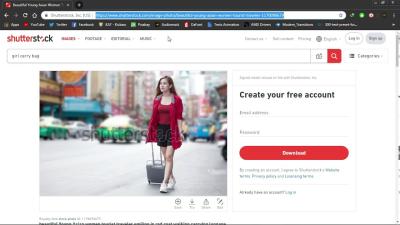Got a few good photos or illustrations but think you’re not enough to earn on Shutterstock? Think again! Even with a small portfolio, you can start generating income by understanding how the platform works and focusing on quality over quantity. It’s all about strategic submissions, optimizing your content, and leveraging Shutterstock’s tools to get noticed. Whether you’re just starting out or have a handful of images, this guide will show you how to turn those into a steady income stream. Let’s dive into how you can make the most of your limited portfolio on
Understanding Shutterstock’s Platform and Revenue Model

Shutterstock is one of the biggest stock photo platforms out there, connecting talented creators with millions of buyers worldwide. But how does it actually work when it comes to earning money? Well, Shutterstock operates on a royalty-based system, meaning you earn a commission each time someone licenses one of your images.
Here’s a quick rundown of how the platform functions:
- Contributor Account: You sign up as a contributor to upload your images, videos, or illustrations.
- Content Submission: Upload your high-quality content with relevant keywords and descriptions to increase visibility.
- Review Process: Shutterstock reviews your submissions to ensure they meet quality standards. Once approved, your content goes live in their marketplace.
- Licensing & Sales: Buyers browse the platform and license images for various uses—web, print, advertising, and more.
Now, about revenue: Shutterstock pays contributors based on a tiered royalty system. Your earnings depend on your lifetime earnings, the type of content, and the licensing model. Typically, contributors earn anywhere from 15% to 40% per license, with higher earnings possible as your portfolio grows.
Another important aspect is that even with just a few images, if they are unique, high-quality, and in demand, they can generate consistent sales. It’s not always about flooding the platform with hundreds of images but about smartly choosing what to upload and making sure it gets seen by the right audience.
In essence, understanding how Shutterstock’s platform and revenue model work allows you to strategize better. Focus on creating standout content, optimize your keywords, and keep track of your sales to maximize your income—even if your portfolio isn’t huge yet. Ready to start? Let’s explore how to make your limited portfolio work for you!
Strategies for Building a Small but Profitable Portfolio

Starting with a small portfolio might feel a bit daunting, but it’s absolutely possible to make it profitable with the right strategies. The key is to focus on quality over quantity and to be strategic about what you upload. Here are some tips to help you build a small but lucrative collection of images, videos, or illustrations:
- Identify your niche: Think about what you’re good at or passionate about. Whether it’s nature, technology, food, or lifestyle, specializing can help you stand out and attract buyers looking for specific content.
- Research market demand: Spend some time exploring Shutterstock’s top-selling categories. Look for gaps or trending topics that you could create content around. Tools like Shutterstock’s Contributor Dashboard or even Google Trends can give you insights.
- Create a core set of versatile images: Instead of flooding your portfolio with many similar shots, focus on a few high-quality images that can be used across various projects. Think about images with broad appeal, like clean backgrounds, natural settings, or simple objects.
- Leverage existing skills and resources: Use any equipment, editing software, or knowledge you already have to produce content efficiently. This saves time and helps you maintain consistency.
- Consistently upload new content: Even with a small collection, regular uploads keep you visible to buyers and increase your chances of making sales. Set a manageable schedule, like one or two uploads per week.
Remember, building a profitable portfolio isn’t about amassing hundreds of images overnight. It’s about strategic, consistent effort, focusing on what sells, and gradually expanding your collection over time.
Tips for Creating High-Quality and Marketable Content

Quality is king on platforms like Shutterstock. Buyers are looking for images and videos that are sharp, well-composed, and relevant. Here are some practical tips to ensure your content hits the mark:
- Focus on technical excellence: Ensure your images are in focus, properly exposed, and free from noise or distractions. Use a tripod for stability and good lighting conditions whenever possible.
- Use natural light: Whenever you can, shoot during the golden hours—early morning or late afternoon—for soft, appealing lighting. Natural light adds authenticity and warmth to your images.
- Follow composition best practices: Use the rule of thirds, leading lines, and balanced elements to create visually appealing shots. Pay attention to backgrounds and avoid clutter.
- Stay relevant and timely: Create content that matches current trends or seasonal themes, like holidays or popular cultural moments. This increases the chances of your content being purchased.
- Edit with purpose: Use editing software to enhance your images subtly—adjust brightness, contrast, and colors. Avoid over-editing, which can make your images look unnatural.
Besides technical quality, think about marketability:
- Show diversity and inclusivity: Include models representing different ages, ethnicities, and backgrounds to appeal to a broader audience.
- Capture authentic moments: Candid shots and genuine expressions tend to resonate more with buyers than staged or overly perfect images.
- Create versatile content: Think about images that can be used in various contexts—business, social media, education, etc.
In the end, high-quality, marketable content is about understanding what buyers need and delivering it with technical finesse and a creative touch. Keep practicing, stay inspired, and your small portfolio can start generating steady income on Shutterstock.
Optimizing Your Images for Better Visibility and Sales
When it comes to making sales on Shutterstock, simply uploading great images isn’t enough. You want your work to stand out in a crowded marketplace, and that’s where optimizing your images comes into play. Think of it as giving your photos a little boost so they can reach the right eyes and get the attention they deserve.
First, focus on the quality of your images. High-resolution, sharp, well-lit photos tend to perform better. Avoid blurry or poorly composed shots because buyers are often looking for professional-quality visuals. Take the time to edit your images—adjust the brightness, contrast, and color balance so they look polished and vibrant.
Next, consider your image titles and descriptions. Use clear, descriptive language that accurately reflects what’s in the image. Instead of vague titles like “Photo1,” try something specific like “Sunset Over Mountain Lake with Reflection.” This helps Shutterstock’s algorithms understand your image better and match it with relevant searches.
Another tip is to pay attention to the composition and subject matter. Images that are versatile and in demand—such as business, lifestyle, nature, and technology—tend to sell more. Keep an eye on trending topics and seasonal themes, and consider creating images that fit those niches.
| Optimization Tips | Why It Matters |
|---|---|
| Use high-quality, sharp images | Appeals to buyers seeking professional visuals |
| Write descriptive titles and descriptions | Improves search visibility |
| Choose relevant, popular themes | Increases the chance of being found and purchased |
| Edit images for brightness, contrast, and color | Makes your images look polished and appealing |
| Maintain consistency in style and subject matter | Builds your portfolio’s recognition and authority |
Remember, the goal is to make your images as appealing and discoverable as possible. Small tweaks in quality, titles, and themes can lead to big differences in visibility and sales. Pay attention to what works, learn from your successful images, and keep refining your approach.
Effective Keywording and Tagging to Reach Your Audience
Keywords and tags are the bridge between your images and potential buyers. Think of them as the labels that tell Shutterstock what your image is about. The better your keywording, the easier it is for the right audience to find your work—and the higher your chances of making a sale.
Start by brainstorming relevant keywords that accurately describe your image. Use specific terms rather than vague ones. For example, instead of just “dog,” try “golden retriever puppy playing in grass” or “brown retriever resting on sofa.” The more precise your tags, the better your image will rank in searches.
Shutterstock allows multiple tags per image—so take full advantage. Include different angles, moods, locations, colors, and concepts related to your image. For example, if your photo depicts a busy city street, you might add tags like “urban,” “traffic,” “nightlife,” “crowd,” “buildings,” and “cityscape.”
Here are some quick tips for effective keywording:
- Be Specific: Use detailed descriptions rather than broad terms.
- Use Synonyms: Different buyers might search using different words, so include variations.
- Think Like a Buyer: What would someone search for if they wanted your image?
- Avoid Overstuffing: Don’t spam with irrelevant tags. Keep it relevant and concise.
- Research Trends: Check what popular images in your niche are tagged with and adapt accordingly.
Another helpful trick is to look at similar successful images and see what tags they use. This can give you ideas for keywords you might have missed. Remember, accurate and comprehensive tagging not only helps your images get found but also ensures they reach the right audience interested in what you offer.
In summary, mastering keywording and tagging is a key step to amplifying your visibility on Shutterstock. It’s like giving your images a detailed map pointing directly to potential buyers—so invest time in getting this right, and you’ll see your small portfolio start to generate more views and sales.
Leveraging Trends and Niche Markets to Increase Income
When you’re working with a small portfolio, tapping into trends and niche markets can be a game-changer. It’s all about being strategic and proactive rather than just uploading random images. Think of it as riding the wave of what’s popular or underserved in the marketplace.
First, stay updated on current trends. Follow design blogs, social media hashtags, and stock photography forums to see what types of images are gaining popularity. For example, if minimalist design is trending, creating simple, clean images can boost your chances of sales. Similarly, during specific seasons or holidays, themed content often sees a spike in demand.
Next, consider exploring niche markets. These are specialized areas that may have less competition but dedicated demand. For instance, if you have a passion for pet photography, focusing on specific breeds or pet care themes can help you stand out. Niche markets often reward creators who understand their audience deeply.
Here’s how you can leverage trends and niches effectively:
- Research Regularly: Use Google Trends, Shutterstock’s trending sections, and social media to identify what’s hot.
- Create Trendy Content: When you notice a rising trend, produce high-quality images that fit the theme quickly.
- Focus on Niche Topics: Develop specialized collections that cater to specific needs or interests.
- Bundle and Tag Smartly: Use relevant keywords and tags that align with trending topics or niche keywords to improve discoverability.
Remember, being quick to adapt is key. Trends can fade fast, so the sooner you produce and upload relevant content, the better your chances of making sales. Also, don’t be afraid to experiment within your niche—sometimes, a unique twist or creative approach can set your images apart.
By thoughtfully combining trend awareness with niche expertise, even a small portfolio can generate a steady stream of income. It’s all about working smarter, not just harder, and making your limited resources work for you.
Maintaining Consistency and Improving Over Time
One of the most important habits for earning money on Shutterstock, especially with a small portfolio, is maintaining consistency. Think of your portfolio as a garden—you need to tend to it regularly to see it grow and flourish. Uploading new content consistently keeps your portfolio active and increases the chances of being discovered by buyers.
Why does consistency matter? Well, Shutterstock’s algorithms tend to favor active contributors. When you upload regularly, your images stay fresh in the marketplace, and your profile is more likely to appear in search results. Plus, it signals to Shutterstock that you’re committed, which can lead to better acceptance rates and visibility.
Here’s a simple plan to maintain consistency:
- Set Realistic Goals: Decide how many images you can upload weekly or monthly. Even a small, steady pace counts.
- Create a Content Calendar: Planning ahead helps you stay organized and ensures you’re covering various topics or styles.
- Batch Production: Dedicate blocks of time to shoot, edit, and upload multiple images at once. This is more efficient than sporadic uploads.
But it’s not just about volume—you also need to improve over time. Keep track of which images sell well and analyze why they perform better. Use this insight to refine your shooting and editing techniques, explore new styles, or target different niches.
Continuous learning is key. Stay inspired by browsing successful portfolios, taking online courses, or experimenting with new ideas. Over time, your skills will sharpen, and your content will become more appealing to buyers.
Remember, progress might be slow at first, but persistence pays off. Each new upload is a step forward, building your portfolio’s strength and diversity. And as your skills grow, so will your income potential—even if your initial portfolio is small.
In summary, maintaining a consistent upload schedule combined with ongoing improvement creates a sustainable path to earning money on Shutterstock. Focus on quality, stay committed, and keep evolving—your small portfolio can become a profitable venture with patience and dedication.
Conclusion and Next Steps for Small Portfolio Success on Shutterstock
Building a successful portfolio on Shutterstock with a small collection of high-quality images is entirely achievable with the right strategy. Focus on consistently creating and uploading unique, market-relevant content that appeals to your target audience. Remember, quality always trumps quantity—invest time in perfecting your images, ensuring proper keywords, and selecting the best shots to showcase your skills. As your portfolio grows, leverage Shutterstock’s tools and analytics to identify trending topics and optimize your submissions for better visibility.
Here are some practical next steps to maximize your earnings:
- Refine your niche: Focus on a specific theme or style to attract targeted buyers.
- Enhance your skills: Invest in tutorials and courses to improve your photography or design techniques.
- Optimize your keywords: Use relevant and popular keywords to increase discoverability.
- Engage with the community: Participate in forums and feedback loops to learn from other contributors.
- Track your performance: Regularly review your sales data to understand what works best.
Remember, patience and persistence are key. Even with a small portfolio, strategic efforts can lead to steady income and growth on Shutterstock. Keep creating, learning, and adapting, and your small collection can become a valuable asset over time.

